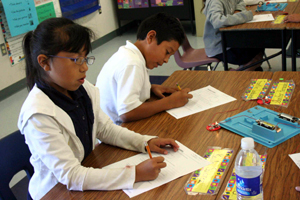Stacy Morrow, who teaches fourth grade at Fair Oaks Elementary School in Redwood City did not need to tell me about her students' enthusiasm for science. It was obvious. Working in teams with a FOSS kit on magnetism and electricity, they could barely contain their excitement at powering a light bulb with a simple electrical circuit.
Like a quarter of California school children, most of Morrow's students are native Spanish speakers. From time to time I'd hear the odd Spanish phrase – along with new English ones, like "serial circuits" and "D-cell batteries" -- drift across the room. Morrow believes that as ESL students, her kids are asked to work much harder than other fourth-graders, mastering a second language along with all the other academic demands of elementary school. It must be a relief, I thought, to engage in a subject where teamwork and experimentation are more important than getting all the words right.
Fair Oaks is a "program improvement school," which means it's been identified by federal No Child Left Behind program as falling below target in certain subjects. (Here's an SF Chronicle article about the "stigma" of Program Improvement status). Morrow says test scores at Fair Oaks are on the rise, but, as this recent New York Times article describes, those standards can be tough to meet even for some of the most improved schools.
Given those demands, it's impressive that Morrow and other teachers at Fair Oaks find as much time for science lessons as they do – (it's also rare, as this study showed). Morrow credits this to the FOSS kits and a supportive administration. But she deserves a lot of the credit, for taking the time to educate herself. The Lawrence Berkeley study also showed that many elementary teachers simply don't feel qualified to teach science. That problem is compounded in economic boom times, when high-paying tech jobs make the pool of science-qualified teachers even smaller. It's fortunate that some of the same industries that compete for workers are also helping train more K12 teachers. Our QUEST education team has put together a page of science education resources, which we invite you to check out.

